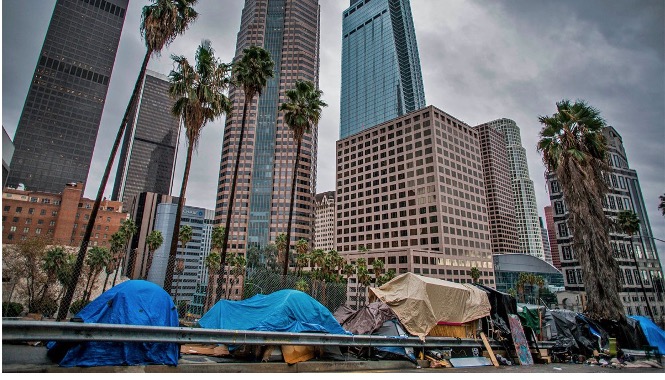Comments
PLANNING WATCH - Like the rest of Los Angeles, Skid Row’s homeless population is growing in the shadows of new high-rise apartment towers with vacant units. It is the same in Koreatown, Hollywood, and other LA neighborhoods with new construction, as shown on the remarkable Los Angeles development map. Furthermore, other large cities, not just Los Angeles, face similar human tragedies because the housing crisis is national, a result of structural forces, not the personal pathology of the homeless.
The band-aid solutions for this human crisis, like Skid Row missions and interim housing, only address visible symptoms, not such underlying causes as the elimination of public housing programs, stagnant wages, spiraling housing prices, weak rent control, and legislation that weakens zoning laws.
For these reasons, Los Angeles, like other large American cities, is in the midst of a housing crisis with no obvious off-ramp. This came through loud and clear in a recent meeting between new LA City Councilmember Katy Yaroslavsky and community leaders from Wilshire corridor communities stretching from Western to San Vicente. At this meeting the neighborhood representatives frequently mentioned LA’s homeless crisis, and how they thought LA’s lax land use practices made it worse. Their intuition was correct.
The California State legislature is forcing cities to up-zone, that is increasing the allowed height and density of residential parcels, while reducing parking requirements. The Legislature – like most local officials and planners -- believes these changes produce more housing, a cornucopia that alleviates the housing crisis. But these junior Reaganites are wrong because increases in permitted density rarely produce more housing. Instead, they result in more unused zoning capacity. For example, LA's long commercial corridors have been zoned for R-3 and R-4 apartments for decades, and they have also been eligible for Transit Oriented Communities (TOC) Guidelines density bonuses since 2017.
Nevertheless, developers ignore this available zoning. Instead, they target a few lucrative neighborhoods, like DTLA and Hollywood, for flipping parcels and/or constructing expensive apartments and McMansions. True, they face extra hurdles when they apply for zone changes, zone variances, and other entitlements that increase the market value of their parcels, but they know that the City Planning Commission bends the rules in their favor 90 percent of the time. They calculated that the extra time is worth the extra profits.
My explanation is that investors make more money by flipping parcels with new zoning entitlements than by building by-right apartments on transit corridors.

Consider the alternatives. In the words of the Reuters news service, banks are sitting on a tsunami of cash and searching for investments that generate a higher rate of return. They could park their money in Treasury bills, where returns max out at 5 percent, or they could gamble their deposits away on the stock market. These lousy choices are why so many banks and large investors favor real estate. The expected annual return on new infill apartments is 15-20 percent, and apartment rents are still rising!
Their best investment option is flipping a parcel. According to the Los Angeles Times, in 2018 flippers made $140,000 per transaction, for a whopping return of 23 percent. This explains why investors lead the charge for zoning entitlements that lift the value of their parcels. Furthermore, compared to other investment alternatives, such as the stock market, it is hard to complete with real estate, where the chances for appreciation and steady cash flow are hard to beat. One reason is that Angelenos shell out $40 billion per year in rent, a financial factor that drives real estate prices ever higher. This is also why so much external investment in Los Angeles real estate is made by companies looking for higher rates of return. As for such alleged benefits as providing shelter to the homeless, reducing inequality, and increasing transit ridership, these are strictly contrived cover stories to generate public support. They do not guide investment decisions.
The advantages of speculative real estate investments also explain why major real estate companies, like Blackstone, are aggressively buying homes in Los Angeles, “inadvertently” causing real estate prices to surge ahead of wages.
While few Angelinos invest in these speculative real estate projects, many more, like those on Councilmember Katy Yaroslavsky’s call, now realize that:
- Real estate investors have little difficulty obtaining City Hall zoning waivers that lift the market value of their properties by permitting more uses, height, and density.
- This increase in property values leads to flipping and higher rents.
- Spiraling rents and sales prices also lead to homelessness, overcrowding, and rent gouging.
- Since elected officials benefit from City Hall pay-to-play, they rarely call for strict enforcement of local zoning laws and building codes or actively oppose the deregulation of zoning and planning laws in Sacramento.
- Up-zoning makes the housing crisis worse, not better.
This is why the blowback from these decisions -- homelessness, overcrowding, and inequality – is the real cost of City Hall-supported real estate speculation.
Will the newcomers at the City Council and the Mayor’s Office, like the public officials who preceded them, go with the flow? We don’t know, and this is why public pressure will hopefully make a difference.
(Dick Platkin is a retired Los Angeles city planner who reports on local planning issues for CityWatchLA. He serves on the board of United Neighborhoods for Los Angeles (UN4LA). Previous Planning Watch columns are available at the CityWatchLA archives. Please send questions and corrections to [email protected].)
















